"You were wrong case.
To live here is to live."
 /
License & Download /
Tutorials /
Cookbook
/
License & Download /
Tutorials /
Cookbook
 /
Contact & Hire
/
Contact & Hire
|
MollyPages.org
"You were wrong case. To live here is to live." |
Pages /
Database /
Forms /
Servlet /
Javadocs
 /
License & Download /
Tutorials /
Cookbook /
License & Download /
Tutorials /
Cookbook
 /
Contact & Hire /
Contact & Hire
|

For the best (by far) overall reference on this topic, see:
Parsing Techniques - A Practical Guide by Dick Grune and Ceriel J.H. Jacobs.
The section (below) on LL(1) recursive descent parsing is rather comprehensive and complete (I've worked out all the possible edge cases in the various examples).
Note 1: Keep in mind that a lot of theory-of-computation literature takes a pseudo-mathematical approach with "sets", which is the last refuge of the untalented and uninspired. A real mathematician would, in my opinion, -barf- at the mindless, un-intuitive and useless formalism-for-its-own-sake approach.
Note 2: The best approach, as always, is to both write and examine as much real code and real programs as possible.
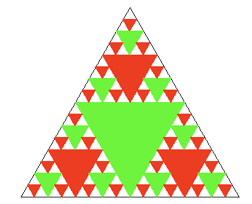
 Grammars describe hierarchical structures.
Grammars describe hierarchical structures.
These structures can be self-similar or nested at various levels.
A self-similar structure is called a fractal. There are many ways to describe fractals.
One such way is Lindenmayer-systems (L-systems). These are a type of grammar that can generate/describe recursive structures like Koch curves, Sierpinski triangles and various other fractals.
Here's a simple Grammar:
X -> a X bThe structure X is composed of a X b ...which contains X itself ! Therefore this is self similar/fractal structure, because it contains itself.
Replacing X by its right hand side, we get:
-> a (X -> a X b) b -> a a X b band so on:
-> a a (X -> a X b) b buntil we get tired and stop using the X entirely (we say X -> ε [empty/erased])
One can think of a grammar as a recursive drawing template, where parts of the drawing (called non-terminals in grammar speak) are replaced with other drawings, possibly even with the same drawing as the parent drawing.
-> a a a b b b
The left and right hand sides in a grammar rule are arbitrary.
Here's another grammar with 3 rules.
X -> a X b
X a Y -> c
Y -> b X a Y
Using, say, the 3rd rule from the above grammar, any or all of the following
are possible and arbitrary.
Y -> b X a Y -> b a X b a Y
Y -> b X a Y -> b c
Y -> b X a Y -> b b X a Y
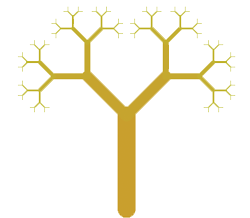 Structured Computer programs in most common high-level programming (HLL) languages can also be
described via a grammar (although this is nearly not as much fun as a graphics
L-system).
Structured Computer programs in most common high-level programming (HLL) languages can also be
described via a grammar (although this is nearly not as much fun as a graphics
L-system).
Consider a program which contains nested if...else statements. We can say:
X -> if (condition) { X } else { X } -> ε (epsilon, i.e., empty)The X can be replaced by other if...else statements. For example:
X -> if (condition) { X -> if (condition) { X -> ε (epsilon, i.e., empty) } else { X -> ε (epsilon, i.e., empty) } } else { X -> ε (epsilon, i.e., empty) }..resulting in the program:
X -> if (condition) { if (condition) { } else { } } else { }Computer programs are nested. Grammars describe nested structures.
So, to parse a computer program (like the if..else program above), we try to create a grammar that we think can be/was used to generate the program.
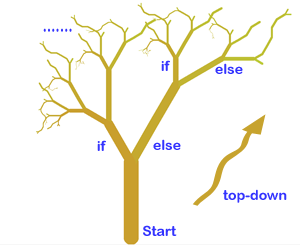 We use this grammar to
try to generate all possible programs, including the program we are analyzing. The grammar can create an
arbitrary number of different possible programs/structures, including programs we care about.
We use this grammar to
try to generate all possible programs, including the program we are analyzing. The grammar can create an
arbitrary number of different possible programs/structures, including programs we care about.
If we cannot generate our program from the grammar, then either (1) that particular grammar cannot be used for this program or (2) there is a syntax error in the program.
If the program we generate matches the program we have, we have a fit. (this is known as the top-down approach).
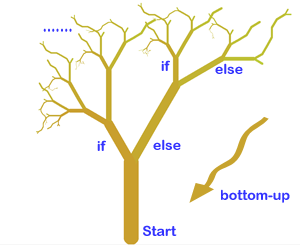 Alternately, can also start with the given program, and try to mash up the individual
pieces into bigger boxes (higher up in the grammar). If all the pieces fit in the larger
boxes, we end up with the original grammar (the largest box being the start rule of the
grammar).
Alternately, can also start with the given program, and try to mash up the individual
pieces into bigger boxes (higher up in the grammar). If all the pieces fit in the larger
boxes, we end up with the original grammar (the largest box being the start rule of the
grammar).
In either case, we note down the series of grammar rules/productions that were applied
to get to the end result. We can then use these same rules to write another lower level
program (say in machine code). We have effectively transformed one language into
another.
Note, there might be more than one way to generate our program from the grammar (using the top-down approach) or more than one way to consolidate our program (using the bottom-up approach). This is perfectly fine but such grammars are called ambiguous. For keeping things simple and to give programs we write a definite and single meaning, we tend to disallow ambiguous grammars when describing programming languages.
While choosing grammar rules, we can also use the program we are analysing to help reduce the number of possible choices that we have to follow in our grammar. For example, if the next input sentence in our program is "then", and we have the following 2 rules:
X -> if then X X -> if XWe only need to choose the first rule (since the second rule doesn't contain then at this point).
Restricted grammars with (1) only one non-terminal on the left hand side and (2) the ability to choose a single top-down rule at any point (based on the program we are analysing) are called LL(1) grammars.
Consider this simple program:
if ( x = 1 )
print "hello"
else
print "goodbye"
Corresponding to this is the simple grammar:
X -> if ( COND ) STMT else STMT COND -> letter == number STMT -> print textApplying our grammar and noting the rules used, we get the parse tree:
RULE:
X ->
if
COND ->
letter: x
=
number: 10
STMT ->
print
text: "hello"
else ->
STMT ->
print text: goodbye"
This parse tree is then converted into machine code that may look like:
1: LOAD X FROM MEMORY [100] 2: COMPARE X 1 3: JMP_ON_EQUAL GOTO LOCATION 10 4: PRINT "goodbye" 5: STOP 10: PRINT "hello" 11: STOPBoth the parsing of the program (in a parse tree) and the conversion of the parse tree into machine code can be automated and done by a computer program. Write a program to translate other programs...pretty cool!
Such a program is called a compiler/translator.
This leads to a chicken and egg problem. If our compiler/translator itself is a computer program written in a high level language, how do we use it ? We need to first convert the compiler program to machine code in order to run it. But we cannot convert the program to machine code because we don't have any compiler in machine code and we need the machine code version to compile any program at all (including itself).
It is not intuitively obvious whether such a compilation/translation is even achievable via computer/mechanical means. But it turns out that computers, indeed are capable of doing this conversion.
The following table shows how the above 3 dimensions interact.
| Top Down | Bottom Up | |
| Directional | Unger method | CYK method |
| Non directional |
These are typically implemented using recursive descent. |
These are typically implemented using shift/reduce. |
Regular grammars have production rules of the form:
S -> any combination of Terminals. There can only be 1 non-terminals that
can only appear left most or right most.
There can be more than one production for a given left hand non-terminal
and ε productions are allowed.
S -> X -> Y -> εFor example:
X -> a X X -> a b X | abRepetitions are specified as:
X -> a | ε 0 or 1 a a? X -> a X | ε 0 or n a's a* X -> a X' 1 or n a's a+ X' -> a X' | εBack-references are not regular. For example to match: beri beri, one might say:
(.*)\1However, this is not a regular expression but a context free grammar of the kind:
X -> YY Y -> anychar YA very common task is to find a delimited string with embedded escape sequences. The delimiters can be any character or string, for example:
Delimited by a quote: ".....foo\n \"....." Delimited by <x>: <x>.....\<x>.....<x>Regular expressions/grammars can be used to match these constructs. For example:
".....foo\n \"....." is matched by "[^"]*"
<x>.....\<x>.....<x> is matched
by "(\.|[\"])*". This regex is slightly tricky
since, we cannot use character classes for more than one character. We
cannot say: "[^<\x>]*" since that would match any of < \ x > singly (not as a
sequence). The \. matches the escape sequence of ANY length
such as \<xmp> or \" first.
Then the second alternative [^\"] matches any char which is not a
\ or a "
A lexer is a program that breaks down its input into tokens. The tokens are usually specified by regular grammars/regular expressions.
Regular grammars can also be visualized as finite automata. Switching from state to state is the same as following a particular production in the grammar. An automaton switches states based on the next input item that it reads. A non deterministic finite automa (NFA) is the same as a grammar in which more than one production/rule can be chosen at a given point. One can then choose several productions which is the same as being in more than one state at a given time.
An implementation may accomplish this in parallel or via backtracking or via converting a NFA to a DFA (which is essentially in parallel)
Finite automatons are often easier to visualize than the equivalent grammar notation.
Here's a grammar that generates sentences of the form: ab*a
S -> a X a X -> b X -> εEquivalent finite automaton:
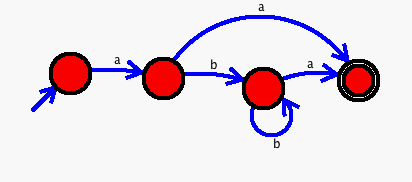
Only 1 Non Terminal -> any combination of Terminals and Non-Terminals.Like regular grammars, context free grammars can also have more than one production for a given left hand non-terminal.
A -> X -> YFor example:
A -> X y Z A -> X y XSince the same non-terminal can occur on both sides of a terminal symbol (like
X y X), arbitrarily deep nesting on the left side has to be matched by
the equal symbol on the right side. Therefore, nesting to any depth can be represented
by context free grammars.
This is equivalent to just keeping a count of the depth on the left side and matching that with the right side, so we are simulating a simple counter variable (or equivalently a stack) with this grammar.
Grammars can often be simplified by the following methods.
S -> aA A -> b -> ε [to be eliminated]A derives ε. Look for all other productions in which
Aappears on the r.h.s. An ε on the r.h.s means that the production can disappear (i.e., A*) and removing ε converts a choice between a production vs. ε to a choice between other productions. For example:
S -> a AAdd another production with A removed. (i.e, apply A -> ε).
1) Add:
S -> a
2) Then remove the ε-production:
A -> ε
Final result:
S -> a A -> a [added]-> ε[removed] A -> b
1 S -> A B A 2 A -> x 3 A -> εThen we cannot just replace:
1 S -> x B xInstead we have to add the following:
1 -> B A 2 -> A B 3 -> Band then apply: A -> ε in all of the above. This results in:
2 S -> B x 3 S -> x B 4 S -> BNow remove: A -> ε, so we get:
1 S -> A B A 2 S -> B A 3 S -> A B 4 S -> B 2 A -> x
1 S -> A B A C 2 A -> a A 3 -> ε 4 -> b B 5 -> ε 6 -> cReplacing
A -> ε, we now get additional productions:
1 S -> ABAC 1.1 -> BAC [first A removed] 1.2 -> AB C [second A removed] 1.3 -> B C [both first and second A removed] 2 A -> aA 2.1 A -> a [A removed]Replacing
B -> ε in all of the above, we
get the following additional rules.
this now becomes:
1 S -> ABAC
1.4 -> A AC (remove B from 1 above)
1.5 -> AC (remove B from rule 1.1 above)
1.6 -> A C (remove B from rule 1.2 above)
1.7 -> C (remove B from rule 1.3 above)
4 B -> bB
4.1 B -> b (remove B)
Note, two of the resultant rules are of the form
S -> AC which can be consolidated. These extra rules are added
to the original grammar and the ε-rules are removed. The final
result:
S -> ABAC -> ABC -> BAC -> BC -> AAC -> AC -> C A -> aA A -> a B -> bB B -> b C -> c
1 A -> B 2 B -> xyIn this grammar, A -> B is called a unit production. A unit production is a rule in which the right hand side of the rule contains only one symbol and that symbol is non-terminal. In this example, only B appears on the r.h.s of rule 1 and therefore this is a unit rule.
This rule does not add anything to the kind of sentences produced. The above grammar can be written more simply as:
A -> x yEliminating unit productions makes grammars clearer. To eliminate unit productions:
1) Select a unit production from a pair of grammar rules that look like:
A -> B B -> ∂ [∂ is any non-unit right hand side]2)
Add: A -> ∂ Remove: A -> B3) Resulting grammar:
A -> ∂
A -> B B -> C C -> D D -> xStart with:
A -> BSelect:
B -> CThis is a unit production too, so select
C -> DThis is a unit production too, so select
D -> xThis is a non-unit production, so use:
A -> xThe final grammar is:
A -> x
1 S -> AB 2 A -> a 3 B -> C 4 -> b 5 C -> D 6 D -> E 7 E -> aThree unit productions exist
3 B -> C 5 C -> D 6 D -> E
B -> C. No non-unit C -> ... productions exist. Stop. Try Step (2). C -> D. No non-unit D -> ... productions exist. Stop. Try Step (3) D -> E. Aha. E -> a is a non-unit rule. So:
Add the non-unit rule: D -> a (because E -> a) Remove the unit rule: D -> EStart again. The following are still left to eliminate.
B -> C C -> DFollowing the steps as before, we get: For rule
C -> D
Add: C -> a Remove: C -> Dand then for Rule
B -> C
Add: B -> a Remove: B -> CThe grammar now looks like:
1 S -> AB 2 A -> a 3 B -> a 4 -> b 5 C -> a 6 D -> a 7 E -> aHowever, since C, D and E are unreachable from S, the final grammar is:
1 S -> AB 2 A -> a 3 B -> a 4 -> b
A -> A x -> y -> εApplying the rule
A -> ε initially, we get ε.
Applying the rule A -> A x we get:
Ax Axx Axxxand then we get:
Ax -> x (A -> ε) Axx -> yxx (A -> y) Axxx -> yxxx (A -> y)Therefore the grammar gives us either an ε, or [0_or_1 y followed by 0_to_n x]. Therefore, eliminating left recursion we get:
A -> y A' | ε (1 or 0 y) A' -> x A' | ε (0 to n x's)
A -> A x -> ybecomes:
A -> y A' (1 y) A' -> x A' | ε (x's)
The following grammar
A -> A d | A e | a B | a Cbecomes:
A -> a B A' | a C A' A' -> d A' | e A' | ε
Parsing context free grammars is easiest using a top down, breadth-first searching, wherein the source text determines the rules that can be applied (starting from the start rule) and if more than one rule can be applied, than each choice is examined in parallel. This is called non-deterministic parsing.
This however can have a large time/memory use and in practice, therefore to cut down on having to chooose all possible rules, most parsers are deterministic. This means that the grammar rules are structured in such a way that depending on the next few source tokens [typically, 1 hence LL(1)], only 1 grammar production can be applied. (hence the rules can be applied deterministically).
First Sets are defined as follows:
For some production:
S -> α Y β [where α, Y, β could be terminals or non-terminals] first(S) = first(α Y β)For a grammar to be LL(1), first sets for all productions (right hand sides) for any ONE left hand side must be disjoint.If α is a terminal first(α Y β) = α else calculate first(α) if first(α) contains ε (can contain others too) first(α Y β) = first(α) - {ε} U first(Y β) [Note 1] else // (if first(α) does not contain ε) first(α Y β) = first(α) Note 1: first(Y β) is recursively calculated in a similar manner. However if we get to first (β) and that does contain ε, then since β was the last non-terminal, that final ε is included in the first set. (we must look at follow sets in this case to decide whether to choose ε).
S -> A C B
-> C b B
-> B a
A -> d a
-> B C
B -> g | ε
C -> h | ε
first (S -> ACB) = first (A C B) = first (A) = {d, g, h, ε} first (A) contains ε = {d, g, h, ε} - ε + first (C) = {d, g, h} + {h, ε} first (C) contains ε = {d, g, h} + {h, ε} - ε + first (B) = {d, g, h} + {h, ε} - ε + {g, ε} first (b) contains ε. But we do not subtract ε since B is the last item in our S -> A C B = {d, g, h, ε} first (S -> CbB) = first(CbB) = first(C) = {h, ε} = {h, ε} - ε + first(b) = {h, b} first (S -> Ba) = first(Ba) = first(B) = {g, ε} - ε + first(a) = {g, a} first (S) = first(ACB) = {d, g, h, ε} + first(CbB) = {h, b} + first(Ba) = {g, a}Since the above 3 sets (for the same left hand rule S) are not disjoint, this grammar is not LL(1).
Let's go ahead and find first sets for other productions in this grammar anyway. first (A -> da) = first(da) = d first (A -> BC) = first(BC) = first(B) = {g, ε} //we know first B already from above, time-saver! Since first(B) contains ε = {g, ε} - ε + first(C) = {g} + {h, ε} Since C was the last item in the rule, we do not subtract ε. = {g, h, ε} first(B -> g ε) = first(g, ε) = {g, ε} The last ε is included first(C -> h ε) = first(h, ε) = {h, ε} The last ε is included
A -> aB | ε B -> athen we could potentially choose
A -> ε (since both {ε, a} are in A's first set.
A -> ε is the right choice in a deterministic parser, when the
next input terminal matches the symbol immediately following A in some
production. The set of all terminals following A are known as
A's Follow Set.
A -> a | ε X -> A bb follows A in the production X -> A b.
Therefore: follow (A) = b and we can use the
following production selection table.
Generally speaking, to calculate follow sets:
STATE Next symbol b a A A -> ε A -> a
1. For a rule of type:
A -> α X β
where α, β are any sequence of terminals & non-terminals
follow (X) = first (β) if first(β) does not contain ε
else //if first(B) contains ε
= first(β) - ε U follow(A) [note 1]
Note 1. This is because if β contains ε, then whatever follows A will follow β (since
all of β can become an empty string).
2. Rules of type:
X -> a
X -> abc
X -> ε
do not add anything to the follow set of X itself.
3. For a rule of type:
A -> α X (X is the last item in the rule)
follow (X) = follow (A) [note 2]
Note 2. Because whatever follows X in some rule will also follow A.
Note: ε is never in a follow set. (but EOF (end of
file) may be). The entire point of follow sets is to figure out when to choose
A -> ε for the current non-terminal A (follow sets are useful only
for non-terminals whose right hand side can go to ε). If ε is also in the follow set,
then that would mean the current non-terminal should always go to ε.
Therefore, in the presence of ε, the general rule for deterministic
LL(1) parsing is:
A -> α
A -> β
1. First sets for a given left hand non-terminal must be disjoint. For example,
first (A -> α), first (A -> β) must be disjoint.
2. Furthermore, all first (A) sets AND all follow (A) sets must be disjoint. If
the first and follow sets were not disjoint, then we would not know whether for a given
non-terminal we should apply a non-ε rule or choose ε for that non-terminal.
3. If first (α) does contain ε, then as per rule 1, all other first sets of A
must be disjoint from (A -> α) and therefore no other first set for A can contain ε.
That is:
Follow (α) ∩ First (β) = ∅
S -> a A b
A -> c d
-> e f
X -> A B b c | d e
A -> a | ε
-> b | ε
A slightly modified version of Example 2.
X -> A b c A -> a | ε
S -> A a A b
-> B b B a
A -> ε
B -> ε
S' -> S$ [$ is eof] S -> q A B C A -> a | bbD B -> a | ε C -> b | ε D -> c | ε
S -> A A -> aB -> Ad
S -> aBDh B -> cC C -> bC | ε D -> EF E -> g | ε F -> f | ε
A -> B C B -> A x | x | ε C -> y C | y | ε
And here's a real world surprise - this page you are reading is itself compiled, using the same theory as above. We wrote a translater that takes server side tags (like jsp, asp, etc) but in our own syntax that we like.
Then we parse this page, create a syntax tree and output that into a chunk of Java code (a servlet).
Once we have a syntax tree (also called intermediate representation), we can output into many different end forms (via what is called a backend generator). Many times it is assembler code, or byte code. In this case, it is Java code!
Here's the grammar for Molly server pages.
And here is the actual parser (click on the class name to see the code).